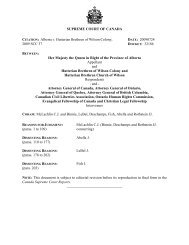Canada (Attorney General) v. Bedford, 2012 ONCA ... - York University
Canada (Attorney General) v. Bedford, 2012 ONCA ... - York University
Canada (Attorney General) v. Bedford, 2012 ONCA ... - York University
You also want an ePaper? Increase the reach of your titles
YUMPU automatically turns print PDFs into web optimized ePapers that Google loves.
Page: 67[152] The appellants seize on this ambiguity and argue that the application judgeapplied the wrong test for overbreadth by asking whether the challengedprovisions were “necessary” to achieve the legislative objectives. Rather, theysubmit, the application judge should have asked whether the effects of thechallenged provisions were grossly disproportionate to the legislative objectives.[153] While we acknowledge that the jurisprudence in this area has been lessthan clear in the past, we are satisfied that the application judge was correct toapply the Heywood test for overbreadth by asking whether the challenged lawswere necessary to achieve the legislative objectives. We say this for tworeasons.[154] First, as we explained above, gross disproportionality was recognized as aprinciple of fundamental justice a decade after Heywood, in the companionmarijuana-related cases of Malmo-Levine, Caine and Clay. But in R. v. Demers,2004 SCC 46, [2004] 2 S.C.R. 489, which post-dated the marijuana trilogy by ayear, the Supreme Court applied the Heywood test with no suggestion that theoverbreadth inquiry had been subsumed by gross disproportionality.[155] Second, and more significantly, in the 2011 case of PHS, the SupremeCourt considered the principles of arbitrariness, overbreadth and grossdisproportionality separately. The Supreme Court found that the exercise of theMinister‟s discretion was both arbitrary and grossly disproportionate, and so
















